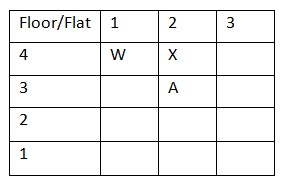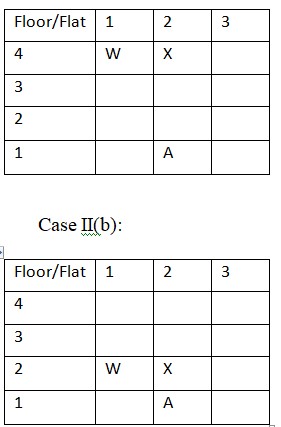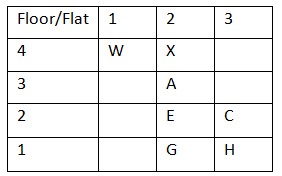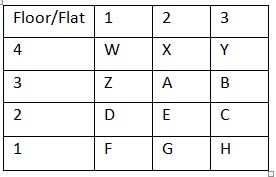Question
--------------- And --------------- don't live in same
type of flat. Answer the questions based on the information given below. 12 persons live in a building, which consists of four floors such that the bottommost floor is numbered 1 and the topmost floor is numbered 4. Each floor has three types of flats (Flat 1, flat 2 and flat 3) such that flat 1 is to the west of flat 2, which is to the west of flat 3. Flat 3 of floor 4 is immediately above flat 3 of floor 3, Similarly, flat 2 of floor 4 is immediately above flat 2 of floor 3 and so on. Only one person lives in each flat. Each of the flat is of equal dimension. A lives in flat 2 on an odd numbered floor. X lives above A in the same type of flat and to the east of W. W doesn’t live on floor 3. C and H live in the same type of flat such that C lives immediately above H but below floor 3. C lives in south east of W. E lives to the west of C. E and G live in the same type of flat and E lives immediately above G. G doesn’t live in flat 1. Y and B live in the same type of flat such that Y lives immediately above B but not in flat 1. Floor number on which Z lives is higher than D, whose floor number is higher than F.Solution
A lives in flat 2 on odd numbered floor. X lives above A in the same type of flat and to the east of W. W doesn’t live on floor 3. So, A lives on flat 2 of floor 3 or flat 2 of floor 1. Case B: A lives on flat 2 of floor 3:  Case II:A lives on flat2 of floor 2:
Case II:A lives on flat2 of floor 2:  C and H live in the same type of flat such that C lives immediately above H but below floor 3. C lives in southeast of W. E lives to the west of C. E and G live in the same type of flat and E lives immediately above G, this is not possible in case II(b), so case II(b) is rejected. G doesn’t live in flat 1, so case II(a) is rejected. So, E lives in flat 2 of floor 2 and G lives in flat 2 of floor 1. C and H lives in flat 3.
C and H live in the same type of flat such that C lives immediately above H but below floor 3. C lives in southeast of W. E lives to the west of C. E and G live in the same type of flat and E lives immediately above G, this is not possible in case II(b), so case II(b) is rejected. G doesn’t live in flat 1, so case II(a) is rejected. So, E lives in flat 2 of floor 2 and G lives in flat 2 of floor 1. C and H lives in flat 3.  Y and B live in the same type of flat such that Y lives immediately above B but not in flat 1 Floor number on which Z lives is higher than D,whose floor number is higher than F. So,Y lives in flat 3 of floor4.B lives in flat3 of floor3.Z lives in flat1 of floor 3,D lives in flat1 of floor 2 and Flives in flat 1 of floor1. The final table is given below:
Y and B live in the same type of flat such that Y lives immediately above B but not in flat 1 Floor number on which Z lives is higher than D,whose floor number is higher than F. So,Y lives in flat 3 of floor4.B lives in flat3 of floor3.Z lives in flat1 of floor 3,D lives in flat1 of floor 2 and Flives in flat 1 of floor1. The final table is given below: 
When a group of computers and devices are connected together, it is called ______.
Which one of the following is an email program?
Minimum number of bits required to store any 3 digit decimal number is equal to
Which of the following statement is correct ?
Main function of CPU is
Which of the following is not an output device ?
URL stands for
What does DBMS stand for?
A half byte is know is
How many colours is used while making a pixel in computer screen?
Relevant for Exams:


